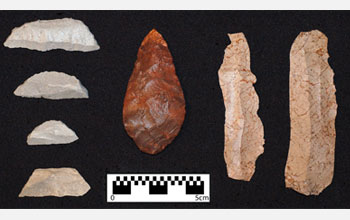All Images
News Release 09-152
Early Fire Use Ignites Discussion about the Evolution of Human Brainpower
Researcher talks about discovery of controlled fire use in Africa
This material is available primarily for archival purposes. Telephone numbers or other contact information may be out of date; please see current contact information at media contacts.

Fire-treated silcrete blocks were used in experimental production of these tools. The raw stone is placed beneath a layer of sand and then a fire is built over the top. The temperature, which is gradually increased and then slowly cooled to avoid damaging the material, is monitored by the use of a thermocouple and data recorder. Evidence at Pinnacle Point, Mossel Bay, South Africa indicates that early modern humans living there by at least 72,000 years ago employed fire to engineer tools from stone.
Credit: Kyle Brown/South African Coast Paleoclimate, Paleoenvironment, Paleoecology, Paleoanthropology Project
Download the high-resolution JPG version of the image. (1.1 MB)
Use your mouse to right-click (Mac users may need to Ctrl-click) the link above and choose the option that will save the file or target to your computer.
Curtis Marean and Kyle Brown, both paleoanthropologists with the Institute of Human Origins at Arizona State University, say the discovery of fired and flaked stone tools in southern Africa helps the understanding of human behavioral evolution. Here, Marean says the finding indicates that humans' ability to solve complex problems may have occurred at the same time their modern genetic lineage appeared some 200,000-150,000 years ago, rather than developing later as has been widely speculated.
Credit: Arizona State University/National Science Foundation

Evidence reported in the Aug. 14 issue of the journal Science shows that early humans living on the southern coast of Africa 72,000 years ago used a complex heat treatment process to manufacture blades and bifacial tools. Unheated silcrete (left) can show dramatic changes in color and texture after heating and flaking (right). An international team, including three researchers from the Institute of Human Origins at Arizona State University, note that silcrete is not found closer than 5 kilometers from their excavation at Pinnacle Point, Mossel Bay, South Africa, and that most pieces found are extensively flaked.
Credit: Kyle Brown/South African Coast Paleoclimate, Paleoenvironment, Paleoecology, Paleoanthropology Project
Download the high-resolution JPG version of the image. (672 KB)
Use your mouse to right-click (Mac users may need to Ctrl-click) the link above and choose the option that will save the file or target to your computer.

Shown is the sieving area located just below the talus slope of the Pinnacle Point Site 5-6 at Mossel Bay, South Africa, with a view across Eden Bay to the east.
Credit: Simen Oestmo/South African Coast Paleoclimate, Paleoenvironment, Paleoecology, Paleoanthropology Project (SACP4)
Download the high-resolution JPG version of the image. (3.7 MB)
Use your mouse to right-click (Mac users may need to Ctrl-click) the link above and choose the option that will save the file or target to your computer.

The South African Coast Paleoclimate, Paleoenvironment, Paleoecology, Paleoanthropology Project (SACP4) at Pinnacle Point, Mossel Bay, is under the direction of Curtis Marean, a paleoanthropologist with the Institute of Human Origins and a professor in the School of Human Evolution and Social Change at Arizona State University. Here the geography of the area along the South African coast is seen.
Credit: Erich C. Fisher/Arizona State University/South African Coast Paleoclimate, Paleoenvironment, Paleoecology, Paleoanthropology Project
Download the high-resolution JPG version of the image. (4.5 MB)
Use your mouse to right-click (Mac users may need to Ctrl-click) the link above and choose the option that will save the file or target to your computer.

The Aug. 14, 2009 issue of the journal Science reports evidence that early modern humans living on the coast of southern Africa some 72,000 years ago employed pyrotechnology--the controlled use of fire--to increase the quality and efficiency of their stone tool manufacturing process.
Credit: Copyright 2009 AAAS
Download the high-resolution JPG version of the image. (908 KB)
Use your mouse to right-click (Mac users may need to Ctrl-click) the link above and choose the option that will save the file or target to your computer.
